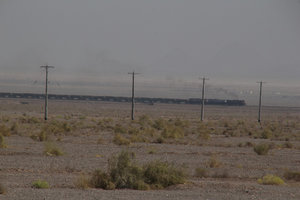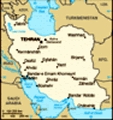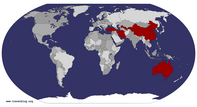Advertisement
Published: October 6th 2013

 Yazd to Esfahan
Yazd to Esfahan
The Great Train Pic. OK its not much .....Yazd to Esfahan
Saturday 5
th October
Today was one of those days that was to be laid back – a simple 330 km trip to Esfahan with one stop to view the Jame Mosque in Naein at about the halfway point. The trip was across desert and it was hot. The truck traffic was heavy. A quick look at the map showed that we were on the main north-south road between Tehran and Bandar-e Bas. The later place is on the Straits of Hormuz and is the major port for Iran. The truck traffic consisted of a wide assortment of cargoes.
Not much happened on the first part of the trip, but as we neared Naein, at a small spot on the map called Noganbad, I spotted an old caravanserai, in fact what I thought was three. I asked Emir if we could stop and he asked on the road or do you want to go down there. Never letting a chance slip by I said if possible I’d like to have a closer look. So off the road and down a dirt track. As we were passing between two of the building Emir

 Yazd to Esfahan
Yazd to Esfahan
Noganbad - the old citadel which is probably at least 1400 years old. Now used to pen livestock.stopped to talk to an old farmer who was going the other way on foot. Friendly guy with only one tooth in his head.
The old guy informed us that the first building which was in better condition was indeed an old Safavid Caravanserai. Being Safavid it was at least 400 years old and disused (in a way). The then Safavid Shah ordered (according to Emir) 1000 identical caravanserai to be built across the country on the major caravan routes. This was one of those. It wasn’t in too bad a condition for its age and its current use. It was being used by local farmers as a store house and a place to stable their stock in winter. As a point of interest the structures went out of use many years ago. However the last Shah found a use for them during the 1950s through to his ousting. That use was due to their large number of rooms and holding capacity for storage. He turned them into Police Stations and jails. People were what was stored in them.
The guys using the place allowed us to look it over, which we did even going onto the roof.

 IMG_7283
IMG_7283
Noganbad - The Caravanserai looking along the eastern wall. Photo taken from the south.Emir said that with a bit of money the place could be made into a decent hotel. He was right. Structurally the place was quite sound. While we were there a couple of Traffic Police dropped by and parked their car in the shade (this was about 300 metres off the main road) and had a bit of a bludge. I guess they could as one of them had more stars on his shoulders than a Posse of US Marshalls.
We then went to look over the next building, which according to the locals was an old citadel predating the Islamic period. That made it at least 1,400 years old. The building was made from mud brick and was in poor state of repair. The interior of the structure, that is all the rooms etc were gone except for two small cellar type rooms in two of the corners. Basically all that was left was the gate house, the outer walls and the four towers in the corner (at least part of the towers that is). The current use is as a “stockyard” – the large open area is used for holding stock. Based on the poo – sheep

 Yazd to Esfahan
Yazd to Esfahan
Noganbad - just inside the main entrance to the caravansarai. Now used for storage and as pens for stock.and camels.
The third building, again according to the locals was another even older Citadel. It was smaller than the other citadel and in worse state of repair. Again it was used for storage and stock. Parts of some of the interior rooms are still in existence. There were two other smaller structures: a separate tower of similar design to the caravanserai. My guess is that it may have been a watch tower, or fire tower (light house). Its door was about 3.5 metres from the ground and there was no sign of stairs, nor of any other associated structure. I noticed that between this building and the main caravanserai was a thin scattering of broken pottery of indeterminable date. The last structure was some distance away and was a “reservoir” but was not associated with the Qanats system in the desert. The reservoir, or really a soak/well, was built in the lowest part of a shallow basin. Being at the lowest point the surface and sub-surface water gravitated to it. The locals also told us that the main caravanserai was once connected by underground clay pipes to a water source 8 km away. They showed us some of

 Yazd to Esfahan
Yazd to Esfahan
Noganbad - the courtyard of the caravansarai.the “pipes” that they had found. These were actually an open channel drain with flat stones for the top.
All in all the visit was well worth it and I was glad I asked Emir to stop. He was just as interested as I was and said afterwards he is getting to know what I like to see. Oh yeah! I actually photographed my first “real” train today. It was about 900 metres away across the desert, but I got it.
Our next stop was in Naein to see the Jame Mosque. OK, I’ll tell you what a Jame mosque is. There are three types of mosques: Jame, Friday, and local. The last two are self-explanatory. A Jame Mosque is by far the most important – they are now not used as they were historically. As well as being a mosque they also had a number of other important uses: court, counselling service (by the Mullah), meeting house, legal office, notary etc. Generally they were/are located in the centre of town with all main streets coming together at the mosque. They were also the first place that a caravan and visitors to the city would head: to find

 Yazd to Esfahan
Yazd to Esfahan
Noganbad - the third structure - the even older citadel adjacent to the caravansarai. Again used for stock pens.out the lie of the land and get information. If need be people could also camp within the walls of the structure. OK so that’s a quick explanation.
The Jame Mosque in Naein is at least 1000 years old. The minaret and Minbar (pulpit) are both 600 years old, and the Dome 700 years. The minaret is 28 metres high and within the mosque are 100 columns (including those downstairs). The mosque is well kept but showing its age: it has also suffered damage due to earthquakes (columns with a lean). Some columns have been reinforced. The downstairs area is more like a crypt but isn’t. It’s a place where people can go and sit, lie around, chat or whatever on hot days. The temperature was at least 15 degrees cooler than upstairs, which was about 10 degrees cooler than outside. The desert here gets 50 degree temps for days on end in summer. Part way down to the “crypt” there was an underground ablution place (for washing before prayers). It was low down as it was fed by the Qanats.
Whilst there Emir saw a poster for another site about 3 km away. He rang the number

 Yazd to ESfahan
Yazd to ESfahan
Rigareh Qanats Based Water Mill - the 130 metre long tunnel leading to the mill site. The first 15 metres of the tunnel is new as there was a collapse following heavy rain about 5 years ago.and the caretaker came to the mosque and met us and then escorted us to the site. Thank you Emir – a fantastic site. The site was the Rigareh Qanats Based Water Mill – once used to grind grain into flour. As the mill is driven by water from the Qanats which are underground, the mill also had to be underground. The engineering is outstanding. The mill was used up till about 50 years ago, and according to the caretaker who spoke very good English the place dates to the Parthian period (3
rd Century AD). The mill itself, and associated water wheel (which is missing) are 28 metres below ground level, and are approached by a 133 metre long tunnel. The mill could produce 250 kg of flour each day. The wheat and flour were transported to and from the mill by donkeys.
The caretaker (Mahmoud – “same as our last President”) explained the engineering involved in running the place. Amazing. Won’t go into details but Mahmoud said that it can all be found on Wiki Travel – he put it there. Definitely worth visiting.
Onward to Esfahan arriving about 15:30. Initially we got around quite well as

 Yazd to Esfahan
Yazd to Esfahan
Rigareh Qanats Based Water Mill - you find scary things 28 metres below ground level. Tom, my archaeological mate, found a similar sight in a rock shelter once.the traffic was not heavy – later though it was a different matter. Emir suggested that as we had a lot on tomorrow (including getting a visa extension) we could visit the Esfahan Bridges today. OK we did. Very stunning: there are three major bridges and one smaller one, all now foot and bike traffic only. The three main bridges date from the Safafid period so are about 400 years old. The three are: Kaju Bridge (the biggest); Ferdosi Bridge; and Si-o-se Pol Bridge. All are made from stone and multi storied – see the pics – and are stunning. The fourth smaller bridge is called Choobi Bridge (Wooden Bridge which it definitely isn’t). Apparently sometime in the past – Emir nor anyone he spoke to knows when, the timber bridge was burnt down and replaced with the stone structure. It retained its old name. We only got to three of the bridges due to heavy traffic and fading light. The fourth bridge – Si-o-se Pol – will if time permits be seen tomorrow. I hope we do.
Advertisement
Tot: 0.07s; Tpl: 0.012s; cc: 13; qc: 27; dbt: 0.0296s; 1; m:domysql w:travelblog (10.17.0.13); sld: 2;
; mem: 1.1mb
















mj
non-member comment
if you're still there try visiting southern coast , specially qeshm island . it's truly magnificent and based on your blog i'm sure you're going to enjoy it as much as i did .